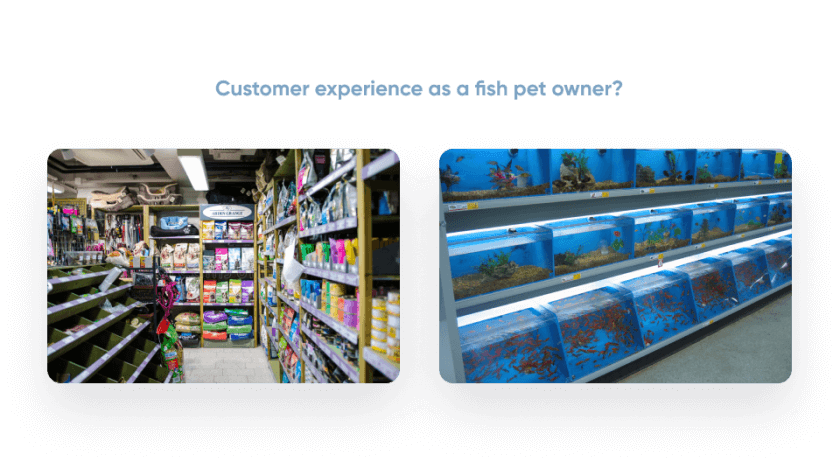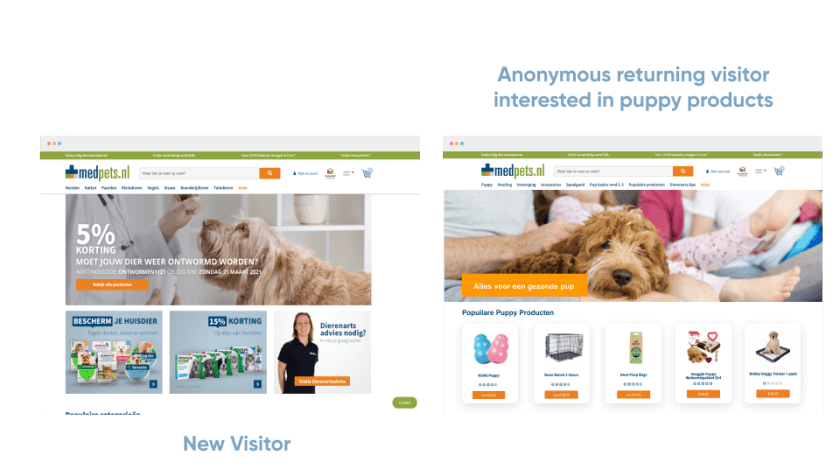 Chris Baldwin
Chris Baldwin
May 31, 2022
 Chris Baldwin
Chris Baldwin
May 31, 2022
Although it might be intimidating initially, quality website personalization is worth the journey to enhance essential eCommerce metrics like conversion, average purchase value, lead generation, and time-on-site. With onsite personalization, brands can have confidence that their content will be valued and appreciated by customers.
With 71% of customers expecting a personalized online shopping experience and 76% of consumers get frustrated when they don’t find it, onsite personalization can unlock solutions that your business craves.

McKinsey found that companies that excel at personalization generate 40 percent more revenue from those activities than average players. Across US industries, shifting to top-quartile performance in personalization would generate over $1 trillion in value. These powerful McKinsey estimates are based on the direct revenue lift that customer intimacy provides. Outperforming campaign strategies are fluent in the impact of personalization and scale this factor to the fullest potential to increase customer lifetime values.
Whether you ask this question to a CMO, marketing manager, or CRO, each will respond differently. The best answer to this inquiry comes from a consumer’s perspective as an end user. Because customers want to be seen for their distinct individuality, and search out websites that notice and attend to their idiosyncratic needs and interests, personalization is a game-changer in as much as it defines the game.
More essentially, customers want brands and websites that feel as familiar as home for them. They want to feel like the experience was built for them, and they want to see empathy from brands throughout their journey. Consumers expect brands to understand these expectations and have the ability to adapt to their evolving needs and desires.

Let’s take the pet store as a metaphor: because dogs and cats reign supreme there, if you are shopping for your fish, you have to go through aisles and aisles of irrelevant products to find that corner of the store. If this were a generic online experience, it’s frustrating because it signals that your brand doesn’t understand me as an individual shopper, given all the extra clicks. It’s not simply sufficient to cater to your buyers in today’s online world; you have to intuit your visitors’ needs through personalization.
Personalization is a solution to this pet store dilemma because it enables you to stitch together anonymous data into a complete optic that defines your entire visitor world. In this way, you can provide customized experiences tailor-made to their interests that in turn make your brand shine from first visit. This helps to convert site visitors into first-time buyers more quickly.
To extend the pet shop analogy, if you have a puppy, you might also want recommendations and content that is responsive to, and evolves with, your pup’s development. As such, the biggest factor that brands get wrong about personalization is that the focus should be on the relationship, not the actual sale. Essentially, if you get the relationship right, the sales follow organically.
In short, to do personalization well, businesses are well advised to strike the right balance between service, brand perception, and consumer experience and are dissuaded from being KPI-driven as an ultimate sales driver.

As you can see in the example above, the new visitor experience is generic, whereas the anonymous visitor who is interested in puppy products gets a more streamlined and relevant website experience personalized to their interests. Over time, as they engage more with the site, add products to their carts, and buy, their personalized experience will match their interests even more.
The goal of any business is to serve customers whose needs can be satisfied. An excessive conversion and KPI-driven focus hurts marketers’ personalization long-game strategy. To be effective, marketers must approach their customer intimacy orientation holistically and collaboratively that can create valuable and memorable customer experiences across each journey. By identifying, recognizing, and understanding each visitor, the marketer can both have a focus on maximizing KPI’s and customer satisfaction. There is a clear maturity model which each business can follow to balance their personalisation effort with quick wins that convert personalization champions from those who were previously on the fence.
Because there are various forms of personalization, here are a few useful tips to focus on to get your onsite personalization game started:
The next horizon of customer service will be built on individual customer profiles, enabling companies to quickly resolve issues and even prevent them from occurring. The future of customer service is already here.
In order to keep pace with this future-forward “white-glove service” internal organization structures need to seamlessly support personalized customer journeys. Because many KPIs bleed into both the job roles of marketing and ecommerce management, marketers would be well advised to have greater training in the UX experience to grasp the full scope of campaign performance. This would include PDPs and page conversions, that typically fall under the ecommerce rubric, to succeed in the long game, despite their strict categorization under the traditional ecommerce umbrella.
Effectively, “there are two primary components to building a highly sophisticated and cutting-edge customer service function: understanding and anticipating customer needs, and implementing enablers to facilitate the development of comprehensive individual profiles of customers.” With respect to the second criterion of implementing organizational enablers, the following interventions are recommended:
That makes a lot of sense because some KPIs are more ecommerce oriented and some are pure marketing. CX typically would fall under ecommerce, not marketing. With digital business KPIs are bleeding into both job roles, too. So it’s requiring you to have a marketer understand UX, and understand search, right?
Organizationally, they need to expand to and have more training, because if you’re a marketer, you would be concerned about campaign performance, but now you’re also expected to think about PDPs and page conversions and things that would typically fall under the umbrella of any commerce manager. I think that’s a nice takeaway, too.
What are some of the skills needed; we need to invest in marketers’ personal development and growth, so they can be more effective and win in the long game.
What is significant to bolster this effort is understanding your customer in order to apply segmentation through first-party data. Specifically, appreciating the most important customer journeys and any pain points on these journeys is key. Be able to define their essential pain points and infuse that into your key metrics. …Adhere to clear metrics that enable you to optimize your capacities. For some quick wins, be sure to apply industry best practices and learnings.
The impact of personalization on the top-line revenue of any business is significant. Both McKinsey and BCG recognizing that organizations who personalize generate 40% more revenue than their industry peers. There is a clear shift in consumer behavior and expectation. Those marketers who focus on the short term KPI’s and those who identify, recognize and understand the consumers behavior. Every organization is on their own path in personalization maturity. This helps organizations to balance top line revenue with investing in personalization programs. With a mature and recognized by Gartner, Forrester and G2 as an industry leading personalisation platform, Insider makes the personalisation growth possible for any organization. With the pre-built, customizable, done-for-you onsite personalization platform, you can go from start to scale with agility. As a performance driver, personalization matters because it gets each consumer to your desired location quickest, and with the fewest unwelcome detours. Data-backed facts aside, it’s that intuitive online capability and touch that customers can feel. This perceived proximity, or customer intimacy, creates a truer connection that your customers will come back for time and again.
If you’d like to know more about how Insider’s personalization software can help your business, get in touch.

Written by
Chris Baldwin
Chris is an award-winning marketing leader with more than 12 years experience in the marketing and customer experience space. As VP of Marketing, Brand and Communications, Chris is responsible for Insider's brand strategy, and overseeing the global marketing team. Fun fact: Chris recently attended a clay-making workshop to make his own coffee cup…let's just say that he shouldn't give up the day job just yet.